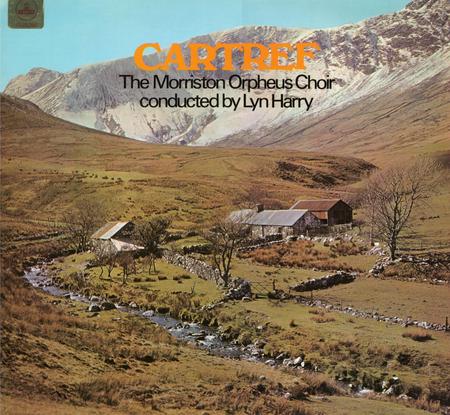75 Years of Song
This article is based on Alun Howell's account in the souvenir booklet for the Annual Gala Concert in May 2010 augmented with extracts from the Choir archives compiled by Roy Pugh and additional contributions from Huw Madoc-Jones, Dudley Williams, Les Ryan and Alan Lewis.
In 1935 the landscape of the lower Swansea Valley was virtually unrecognisable from what it is today. Centuries of over- industrialisation, which had made Swansea the metallurgical capital of the world, had ravaged the lower Swansea Valley, leaving the valley a desolate place where green was conspicuous by its absence. The town of Morriston, sitting at the heart of this area, was to a large extent still dependent on heavy industry, in particular steel and tinplate. This heavy industry, however, coincided with a strong musical and cultural life centred to a great degree in the local chapels. Each chapel had its choir, most being capable of performing the great oratorios and choral pieces of the time. They were also mainly Welsh in language.
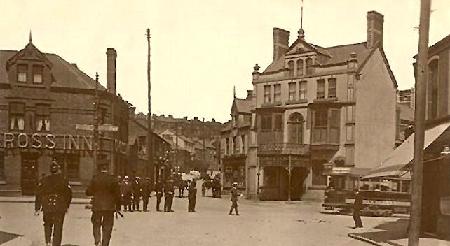 |
| Morriston Cross |
This was the society into which the Morriston Orpheus Choir was born in 1935. Its membership mainly comprised manual workers, most probably in the steel or allied industries, living in or in close proximity to Morriston. More than 90% were Welsh-speaking and came from chapel backgrounds with experience of choral singing and able to read sol- fa.
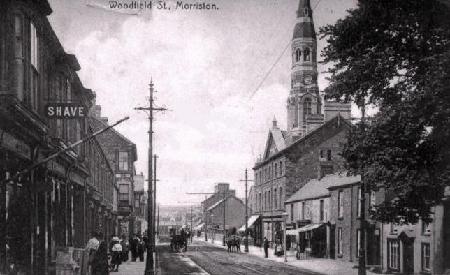 |
| Woodfield Street, Morriston |
In 1935, the chief male choir in Morriston was the Morriston United which had existed as the “Gwalia” choir until its name change in 1924. In 1926 Ivor E.Sims had become the United’s Conductor but in 1934 had left following a disagreement over its future direction. Following a request from members who had left the United with him in 1934, the Morriston Orpheus Choir was formed, with Ivor E. Sims as its first Conductor, and held its first rehearsal at the Wesleyan Chapel vestry on 23rd April 1935.
| In those early years the new Choir concentrated on local concerts and eisteddfodau. The two main events in the year were the Annual Concert and the National Eisteddfod, both of which were always given great prominence in the local press. This was especially true of the chief male voice competition at the National Eisteddfod where the “Evening Post” would give a detailed account of the competition, together with the adjudicators’ comments and the marks gained by the respective choirs. What a contrast to the situation today when the press in general have difficulty in even finding space for the festival itself, let alone individual competitions. |
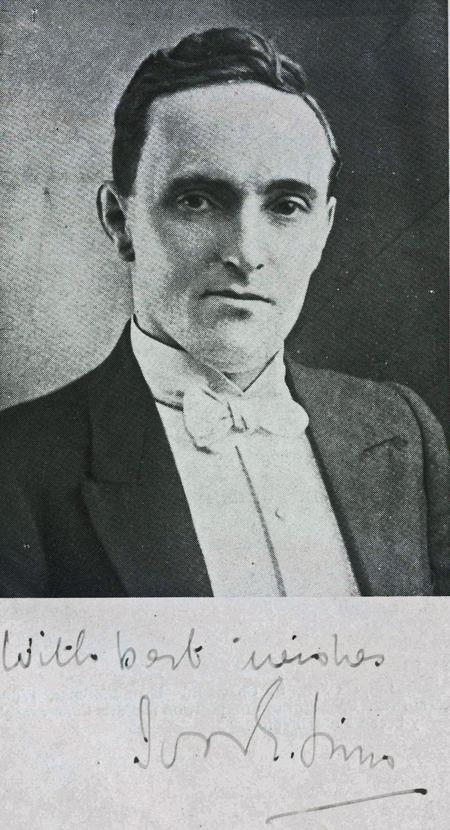 |
| Recollections of Uncle Ivor -click here | Ivor E Sims Founder Counductor |
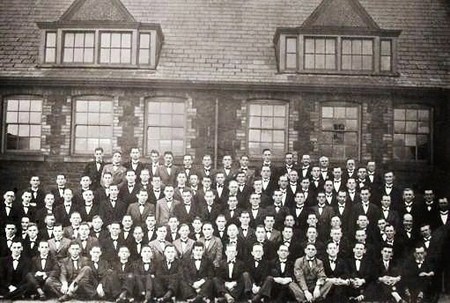 |
|
|
Historic first photo of the Choir outside Pentrepoeth Boys School 1935 |
|
| The Choir achieved its first National success at Machynlleth in 1937 barely 2 years after its formation, and the “Evening Post” recorded the scenes at the Morriston Cross when the Choir arrived home to a rapturous reception from the large crowd that awaited it. Those scenes and newspaper reports are today reserved for football successes. | |
The Choir continued to rehearse and give concerts without interruption during the war years 1939-45. However, nearly all its young men were called up for National Service. The rehearsal room became a canteen for H M Forces stationed in the Swansea area, and competitions were over for the “duration”.
Every singing member who was not called up became a Home Guardsman, a Civil Defence Worker, a Fire Watcher or Special Policeman. The whole nation was mobilised. In spite of these onerous duties rehearsals were never cancelled. Sometimes the attendance of members was so small that singing was out of the question. At other times, when numbers warranted it, the Choir would rehearse with special emphasis on technique and tone.
Often there would be soldiers in the canteen from very far away and the choristers would then entertain them with impromptu items. Many pleasant evenings of this kind were spent between the wailings of sirens and bombings. Sometimes some of these soldiers, having a love of singing, would join with the Choir and become members “pro tem”. One of these was an American G.I. He was a coloured man from Georgia, USA, keenly interested in choral work, a staunch teetotaller and non-smoker. Aware of the fact that there was a shortage of cigarettes and tobacco in the shops, he was kind enough to bring these along to every rehearsal and share out to the members present.
His name was Jeremiah Brown and once while rehearsing Sir Hugh Roberton’s arrangement of “Ar hyd y nos” he fell asleep, having been on duty for longer hours than usual and yet he was so conscientious that he felt compelled not to miss any rehearsals. He was a grand fellow and when his unit left the area he was presented with a framed certificate certifying that he was a full member of the Morriston Orpheus Choir. He treasured this very much and said “Thank you, boys. This’ll be hanging in my best room – Oh boy!”
In 1942 the Choir travelled to Worthing to give a special concert. Read more.
 |
In 1944 Ivor E Sims' Morriston Boys Choir recorded the world premiere performance for boys voices of Benjamin Britten's A Ceremony of Carols. Read more about this. The Boys Choir was famous at that time, with many of its members later singing with the Orpheus. The Ceremony of Carols recording is still available today on the Pearl label. |
| The Orpheus broadcast on many occasions during the war – one of these was specially recorded for transmission on “Victory in Europe” day, and was nationwide on the “Forces Programme.” Taking part in this broadcast were the Gwaun-cae-gurwen Brass Band, Rhydderch Davies, baritone, and the Morriston Orpheus Choir. | 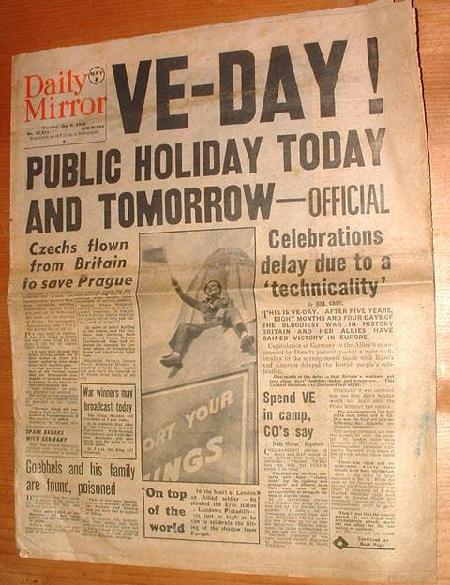 |
Immediately after the War a Complimentary Concert was held in Morriston's Tabernacle Chapel. Read more about this. The Chairman all this time was Mr Morgan Jenkins, and as he had carried this office from 1939 with such dignity and tact under the difficult war-time conditions, it was unanimously decided to allow him to be chairman for the year 1946. List of Choir Chairmen.
Following the end of hostilities, the Choir continued to compete and this resulted in successes at the National Eisteddfod in 1947, 1948, 1949, 1955 and 1960. During this period Ivor Sims also introduced the Choir and South Wales audiences to a more classical repertoire which included Cherubini’s “Mass in D Minor”, Brahms’ “Rinaldo” and the first performance in Britain of Max Bruch’s “Frithjof”.
It was also during this period that new media started to influence choral tastes and demand. Initially, these took the form of radio broadcasts – the Choir became a regular performer on the weekly BBC Radio programme “Welsh Rarebit”, and recordings. The Choir was one of the first Welsh choirs to record for “Columbia” records on the old 78 discs [see discography pages] . Here is a small selection of historic numbers recorded in the 1950s - some numbers are sung with a very slow tempo, so that the music filled the available time on the old 78 records!
In 1956 the Choir was given the then singular honour of appearing in the Royal Command Performance at the London Palladium. The performance was cancelled because of the Suez hostilities but the Choir was again invited in 1957, performing with the local Swansea star Harry Secombe. [more details] The Choir certainly left its mark on the London Palladium audience with one newspaper reporting:
“The audience which up to the Choir’s appearance had been sparing with their plaudits, gave them the first genuine applause of the evening. The Royal Party clapped enthusiastically, the Duke leaned forward appreciatively”
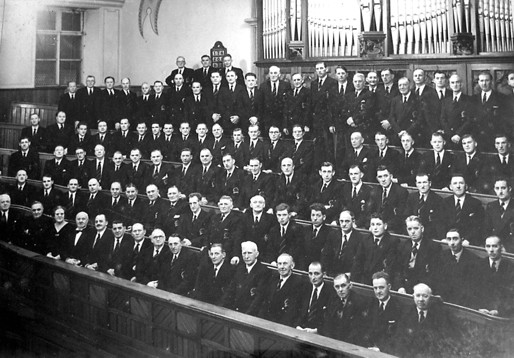 |
| Photo prior to the Royal Command Performance 1957 |
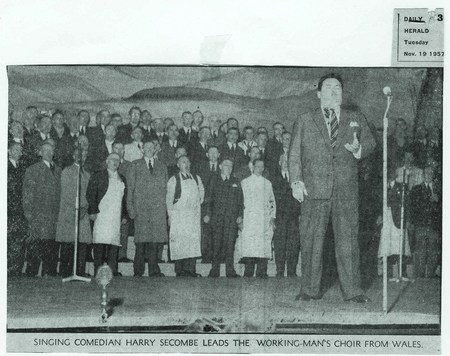 |
| 'Singing commedian Harry Secombe leads the working man's choir from Wales' |
| Photo of performance at London Palladium - Daily Herald |
From the Daily Herald: "Dressed in miners’ helmets, boiler suits and overalls, the 101 strong choir collected one of the biggest ovations of the star-spangled evening with their two songs, “All Through the Night” and “We’ll Keep a Welcome.”
Harry Secombe, the Welsh Goon with the golden voice, introduced the choir.
After singing “On with the Motley” he gave the famous Goon Giggle, cleared his throat and announced; “Now for some culture.” The curtains parted and the choir stood posed against a black backcloth depicting the Welsh hills. “I’ve brought some of the lads along,” said Secombe.” I know them all by name. Listen. ‘Are you there Dai Jones?’ Roared back the Choir in rich unison, “Aye.” The group then went on with their first song and were later joined by Harry Secombe for the “We’ll Keep a Welcome” number.
Following the untimely death of Mr Sims in 1961 the Choir’s accompanist Eurfryn John became the Conductor. The growing importance of the record industry was reflected in the increased recording commitments of the Choir with an average of one long-playing record a year for EMI and the forming of a long-lasting and happy relationship with its producer Bob Barratt.
In 1963 the Choir purchased Nazareth Chapel in Morriston and converted it to be its permanent home. The decision to name it the Ivor E Sims Memorial Hall was unanimous. The hall was used for all manner of cultural activities and its redecoration and partial rebuilding was carried out by craftsmen from within the ranks of the Choir itself. It was the Choir's home until it burnt down in 1980.
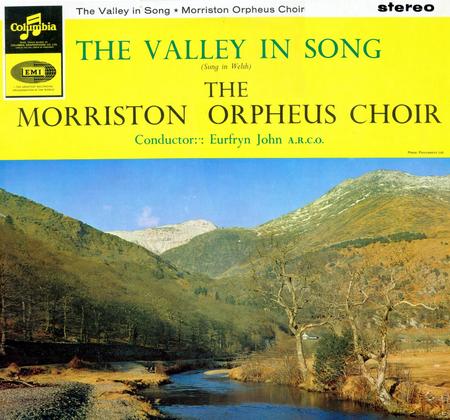 |
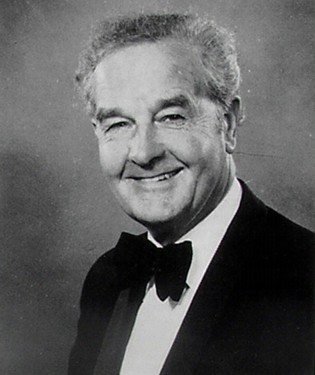 |
| LP The Valley in Song 1965 | Eurfryn John Conductor 1961-69 |
|
Side one Arglwydd da, nid wyf deilwng (Domine, non sum dignus, Victoria.) ~ Iesu O Nazareth (Jesus of Nazareth) (Baritone solo ~ Edward Plucknett)
Side two Sanctaidd Ior (Holy Lord) ~ Matona, Fy Anwylyd (Matona, mia Cara) ~ Tydi a rhoddiast (Thou who gavest) ~ Cytgan y Pererinion (Pilgrims’ chorus) (Baritone solo ~ Edward Plucknett) |
|
Gramophone Review August 1965: "This record is chiefly valued for the two works by Parry which between them occupy about two-thirds of the disc. Both are presented in complete form and are first recordings as far as I know. Victoria's beautiful Domine is fitted with Welsh words and arranged by Williams. The choir is at its best in the original Welsh music, particularly the two extended works by Parry which are imbued with the rich romanticism that the music demands. The tone is rich and round, the discipline is very good and the recording is first class."
In its early years, most of the concerts given by the Orpheus were local, mainly because of transport difficulties. A concert in Cardiff meant allowing 2 hours for travel in view of the possible (probable) hold ups at Neath , Cowbridge and, in particular, Port Talbot. The 1960s brought about the change which has possibly affected the Choir more than anything else since its formation. This was the development of better transport links between Morriston, Wales (apart from North Wales), and the rest of Britain via the new motorways, together with the growth of air links between Britain and the rest of the World. It now became possible to give concerts in London, Birmingham and other English cities without the need for an overnight stay with its attendant costs. It also gave an opportunity for the Orpheus to carry out one of its long held ambitions – that of giving concerts abroad.
On the 20 April 1965, the Choir first ventured away from the mainland. It was under the baton of Eurfryn John and with Jennie Sims at the piano, that the Choir took to the stage at the City Hall in Cork as part of “Welcome to Wales” week in the Irish city. The programme for the day shows the Choir opening its performance with “Arise O Sun” by Maude Craske-Day and ending with Daniel Protheroe’s “Nidaros”. This was followed in 1966 by a visit to Swansea’s twin city Mannheim in Germany. It is worth noting that the journey to Mannheim took almost 48 hours and necessitated an overnight train journey to London followed by an overnight stay in Ostend whereas the more recent visit to Geneva only took 5 hours in total! By 2010 the Choir had undertaken 28 concert tours abroad. Full details here.
In 1969 Eurfryn John resigned and was replaced by Lyn Harry, a native of Llanelli who had been Conductor of the London Welsh Male Choir. He followed the same pattern as his predecessor by carrying on recording for EMI but also introducing a newer repertoire including the first recordings the Choir made with brass and military bands. This was also a period when the Orpheus really became an international choir.
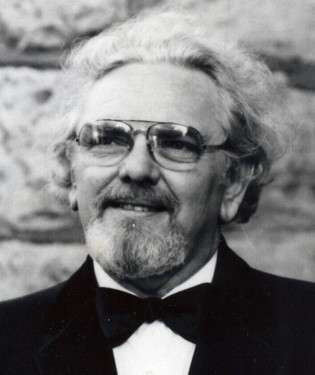 |
Llanelli born Lyn Harry was the former Musical Director of the London Welsh Male Voice Choir in the early 1960s. Lyn came back to Wales in the mid 1960s to a farm in Ferryside, Carmarthenshire. At that time the Choir did not have a deputy to Eurfryn John and Lyn was invited to become the Choir’s Deputy Conductor. In 1969, on the resignation of Eurfryn John, Lyn was appointed Conductor and Musical Director of the Morriston Orpheus Choir and there followed six extremely happy years. The Choir undertook two highly successful tours to North America and recorded six long playing records for EMI. These included “Land of Hope and Glory" with the GUS Band and "En Route" with the Band of the Welsh Guards. Lyn decided to remain in Canada when the Orpheus Choir returned from their 1975 tour. He founded the Canadian Orpheus Male Choir and the Burlington Welsh Male Chorus. He died in 2006. |
| Lyn Harry, Conductor 1969-1975 | |
|
|
Side one
|
|
LP Cartref released in 1972 with Doreen Williams, piano and Les Ryan piano and organ |
Gerwyn Hopkins, Secretary of the Morriston Orpheus Choir in 1972 wrote: "On November 27th 1971 the Morriston Orpheus Choir dedicated its rehearsal room to the memory of Ivor E Sims, their founder conductor. The Ivor E Sims Memorial Hall has become the 'musical home' of this famous choir and it is therefore most appropriate in this particular sense that the Choir's first record release since the dedication be entitled CARTREF - HOME. At this dedication service, which was an important milestone in the history of this Choir, many people paid tribute to Ivor Sims as a man and as a musician. The assembled congregation (which included representatives from 17 male voice choirs) were told that one of his main contributions was the introduction of a new sound in male choral singing which can only be described as a thrilling pianissimo. The introduction and perfection of this new sound gave us the complete dynamic range of vocal range."
Under Lyn Harry, the Choir undertook two visits to Canada and the USA in 1973 and 1975, on both occasions flying from Cardiff via Shannon. During the visit in 1975, the Choir sang in the lobby of the World Trade Centre’s South Tower in New York and was taken to its top floor before it was opened for business. In 2001, the then Chairman and Tour Manager of the Choir were in New York preparing for the Choir’s visit to Carnegie Hall when that same South Tower was destroyed in the terrorist attack of 9/11.
Since those initial overseas visits, the Orpheus has become a true international choir and has well earned its reputation as “The touring Choir”.
It was during Lyn Harry’s time as Conductor that the idea of a formal Supporters’ Group gathered momentum and in 1974 the Morriston Orpheus Choir Subscribers’ Association was formed.
Today MOCSA, with the S now standing for Supporters rather than Subscribers, continues to support the objectives of the original Association:
To support the Choir in all its endeavours, and to encourage the development of young singers with the aid of the Choir
Rarely does the Choir perform to a concert audience which has no MOCSA members present and the Orpheus will always be grateful to those who established the Association and to those who have subsequently helped to run and support it over the years. More details.
To many classical singers in Wales MOCSA is synonymous with “ The Young Welsh Singer of the Year Competition” which is now in its 34th year and widely considered to be the premier competition of its kind in Wales. More details.
| Famous Young Welsh Singer of the Year Competition Winners | |
|---|---|
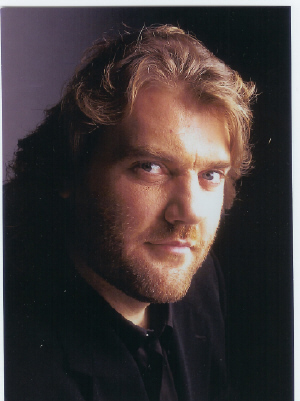 |
BRYN |
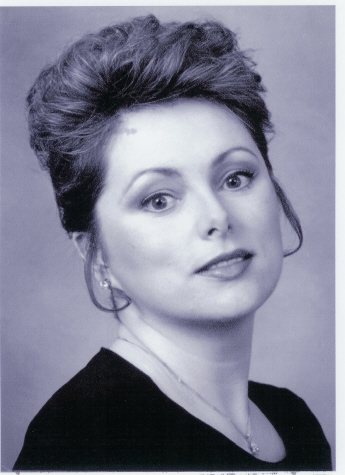 |
REBECCA |
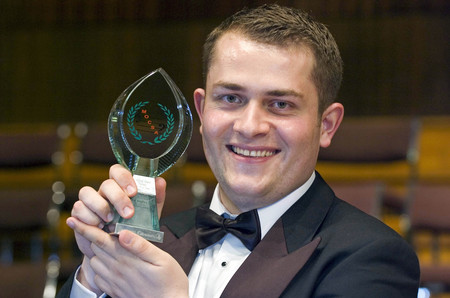 |
GARY |
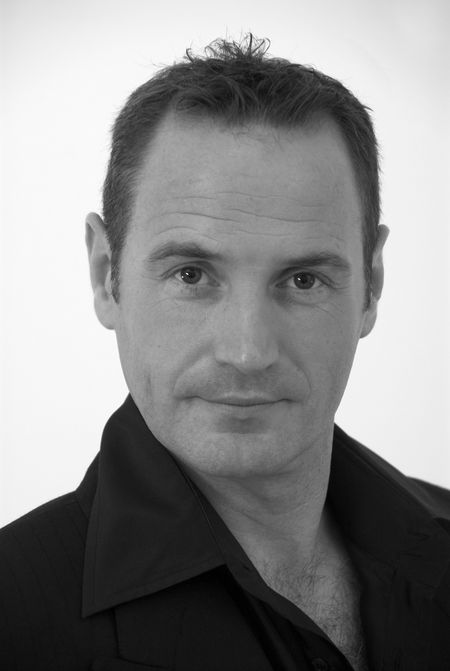 |
ANDREW REES |
.jpg) |
GWYN HUGHES JONES |
At first, the Competition was open only to students studying singing at the then Welsh College of Music and Drama.
The Winner was selected by the Principal of the College and sang at the Annual MOCSA Concert in that same year.
Later the Competition was held at the Choir’s Rehearsal Room and in 1983 developed into the format we know today, but with just one Guest Adjudicator at the Final.
In 2001, an Adjudicators` Panel was established for the Final, consisting of three persons of eminence in the field of music. The composition of the Panel varies from year to year and we are most grateful to all the adjudicators who have contributed in the past so notably to the continuing success of the Competition.
The Young Welsh Singer of the Year Competition is open to students studying classical singing, on a full-time basis only, at any university or college in the United Kingdom and who meet certain Welsh related criteria:
For more details of this annual prestigious award, worth £2000 to the winner, please click here
The first MOCSA Trophy was donated to MOCSA by the British Steel Corporation and was designed by the Chief designer, Mr Harold Christie. The current trophy was designed by the Architectural Glass Department of the Swansea Institute of Higher Education in 2006 and is sponsored by Gravell’s Renault of Kidwelly.
Regular followers of the Choir and MOCSA will remember past winners and how they have progressed. Some are now the 'greats" of the classical music world; Bryn Terfel, and operatic soprano Rebecca Evans. Many of the winners subsequently toured with the Choir. What a platform they have had, singing at world renowned venues like the Sydney Opera House and New York's Carnegie Hall and at such an early point in their careers all thanks to the MOCSA. Full list of winners
When Lyn Harry decided to remain in Canada following the Choir’s visit in 1975, the musical directorship of the Choir was handed to Leslie Ryan who had up to then been the Choir’s deputy conductor, and organist.
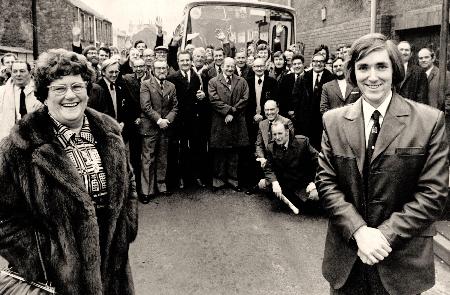 |
| Doreen Williams, accompanist. Leslie Ryan, Musical Director |
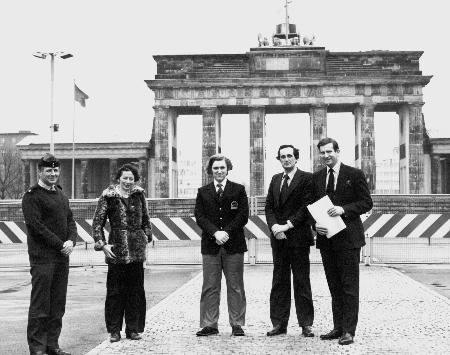 |
|
1977 Berlin. Col. Neville Thomas, our translator, Leslie Ryan, Danny Leahy (Choir Chairman) and Major Sir Michael Parker (Producer and Director of the Berlin Military Tattoo) |
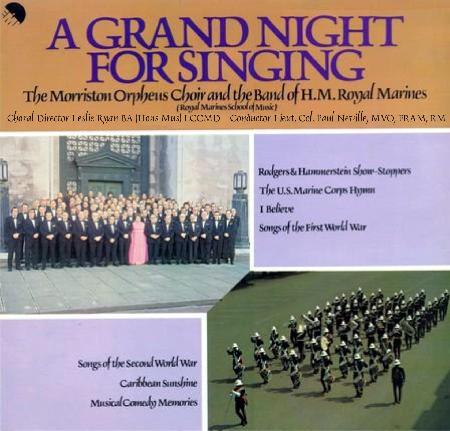 |
|
1976 first LP with the Band of H M Royal Marines |
His period as Musical Director is notable for three important occurrences. Under him the Choir first became involved with Major Sir Michael Parker and consequently appearing in the Berlin Tattoo four times between 1977 and 1990, the recording of two albums with the Band of the Royal Marines School of Music under Colonel Paul Neville, and for his own composition “Sing We Merrily” which is the only original piece of music specifically composed for and dedicated to the Choir. It is featured on an LP of that name and was published by Novello and Co.
.jpg) |
Leslie Ryan was succeeded in 1979 by a young North Walian, Alwyn Humphreys. [read more] This was the beginning of a 26 year period when the Choir went from strength to strength in the recording field, averaging a record a year for that period with EMI in its various guises, Bob Barratt’s own company Grasmere, and with the independent producer Gordon Lorenz.
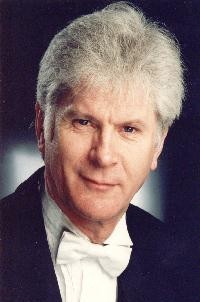 |
'A legend - not only a credit to the world of music, but to the Welsh nation.' So said The Secretary of State for Wales, The Rt Hon Peter Hain MP about Alwyn Humphreys who in January 2005 stepped down after 26 years as Musical Director of the Morriston Orpheus Choir. In recognition of the outstanding contribution he had made during that time, the Choir conferred on Alwyn the title of Conductor Emeritus in March 2005.
|
| Dr. Alwyn Humphreys MBE | |
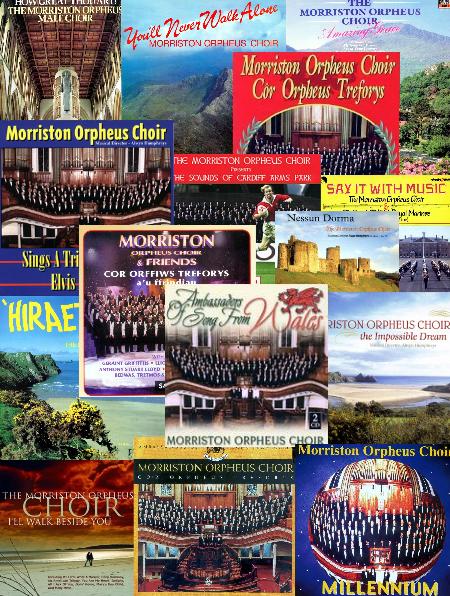 |
|
| A selection of recordings with Alwyn Humphreys as Musical Director | |
During his time as Musical Director Alwyn conducted 623 concerts, made 28 recorded albums (three of which won 'Best Choral Record' awards, with another two gaining Silver Discs), made countless TV appearances, and travelled extensively with the Choir to France, Germany, Italy, Poland, Spain, Canada, the USA, Taiwan, New Zealand, Australia, and most recently the United Arab Emirates and Oman. Among the most notable performances were ones at Carnegie Hall, New York and the Sydney Opera House, both concerts achieving five standing-ovations.
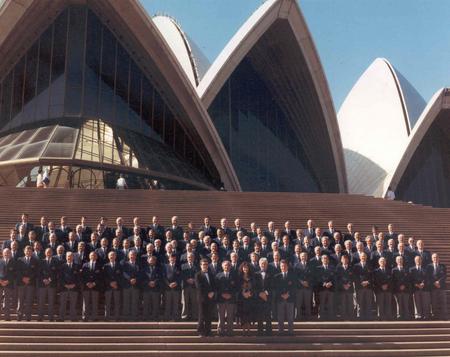 |
| Sydney Opera House |
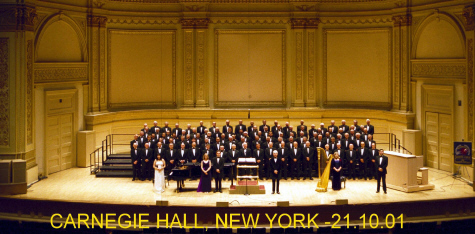 |
After a gap of some 14 years following the 1975 tour to Canada and the USA, a visit to the UK by the Hamilton Orpheus Male Choir from Canada helped to rekindle the transatlantic “wanderlust” amongst Choristers. The President of the Hamiliton Orpheus, Dr Wally Landers, had approached the Morriston Orpheus to host and organise a concert for his choir when they were touring the UK. This was arranged and a friendship developed which has lasted to this day. He was responsible for arranging concerts for our 1989 and 1991 tours of North America and further visits to Canada and the USA took place in 1997 and 2001.
It was also a period of further visits to Berlin, representing Britain at the 1992 Expo in Seville and appearances in front of Royalty and the Pope.
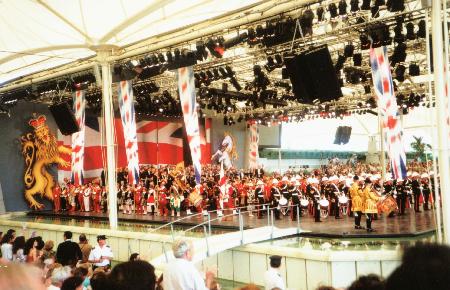 |
| EXPO 92 Seville Spain |
.jpg) |
| Hyde Park 1981 Fireworks Party for Prince Charles and Lady Diana |
It was during the time that Alwyn Humphreys was Musical Director that the reputation of the Choir was enhanced with its many visits abroad, becoming known as the “Ambassadors of Song”.
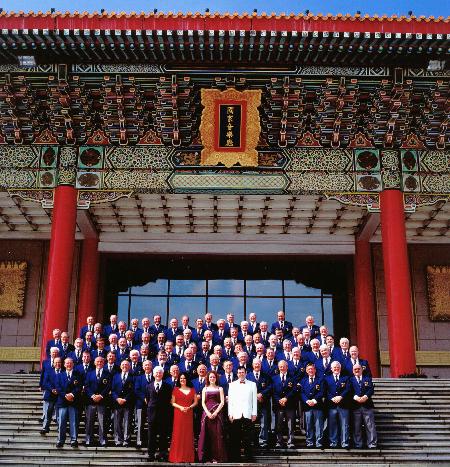 |
| National Concert Hall Taiwan 2004 |
A prime requirement for any choir is the availability of rehearsal facilities. The town of Morriston and its environs has always been able to provide these and the Orpheus has taken full advantage of them. From its first rehearsal in the Wesleyan vestry, the Choir has been able to use chapel facilities for its rehearsals, and the list of places used makes interesting reading. In the early days the Choir used the Forward Movement building in Woodfield Street, and the vestries in Tabernacle, Zoar, and Horeb. It also rehearsed for many years in the fifties and sixties in the Parish Hall.
The Ivor E Sims Memorial Hall, purchased in 1963 burnt down in 1980. The Choir was fortunate to obtain a replacement in Calfaria chapel, but when it fell victim to the ravages of time the Choir moved to the Sacred Heart, which was Zoar in its new incarnation. In 2003 the Choir was fortunate to be invited to rehearse in its current location within a major industrial complex in Morriston. This has been welcomed by choristers, particularly as it provides a haven from car vandalism which had bedevilled some of the previous locations!
It would also be remiss to omit the Choir’s gratitude to Siloh Newydd in Landore and Capel-y-Cwm in Bonymaen for their support during these 75 years.
When Alwyn Humphreys decided to relinquish the baton in 2005 after 26 highly successful years as Musical Director, he was succeeded by Siân Pearce who became the first female Director of the Choir.
|
During her time, the Choir made a further trip to the Antipodes, visiting New Zealand for the fourth time and making its fifth visit to Australia including concerts at the Opera House, Sydney. The Choir also recorded its first CD under the SAIN label called One Thrilling combination.
|
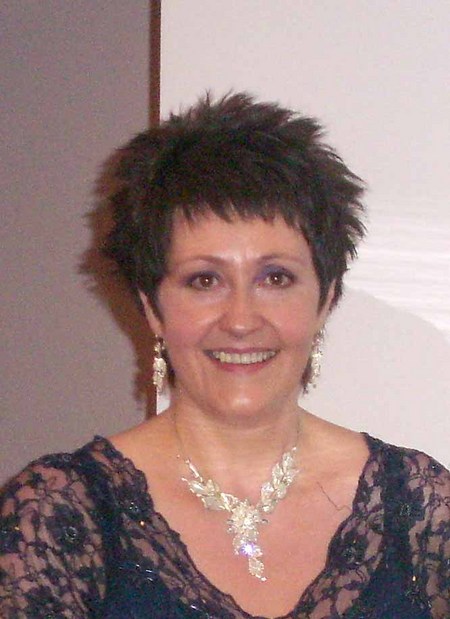 |
| Sian Pearce |
On Sian's resignation in 2007, our present MD, Joy Amman Davies, who had served as the Choir’s accompanist since 1991, was appointed . A year later, in 2008, the Choir undertook its first overseas tour with Joy as Musical Director. It travelled to Geneva to perform a concert in aid of ECLAT, a Swiss-based non-profit making organisation which assists physically and mentally handicapped people in the region of the Pays de Gex. The concert was arranged by Kathleen Brémont. The then First Minister of Wales, The Rt. Hon. Rhodri Morgan AM, was guest of honour at the concert with Dr. Lyn Evans. Mr. Morgan also joined the Choir on its visit to the Large Hadron Collider (LHC) at CERN near Geneva on Sunday 12th October 2008 to meet the Welsh-born physicist in charge of the project, Dr. Lyn Evans. Guest soloists were Gary Griffiths (baritone), Catrin Aur (soprano), accompanists were Jo Scullin, Mike Williams and organist Les Ryan. More details and videos
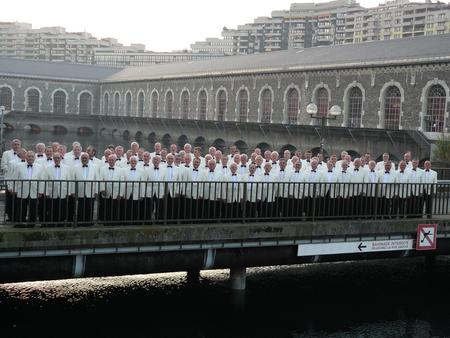 |
| BFM Concert Hall Geneva |
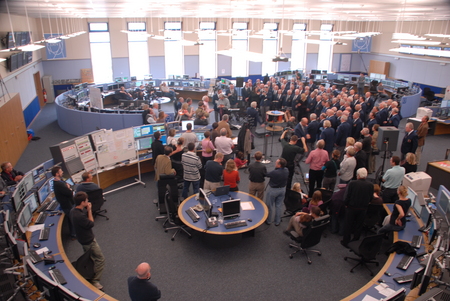 |
| Informal Concert at CERN |
In 2009 came the release of the Choir`s first CD recorded under the baton of Joy Amman Davies, “Nella Fantasia”, followed later in the year by a performance in front of the Queen and other members of the Royal Families of the UK and Qatar, at which Joy presented H M The Queen with a copy of the CD.
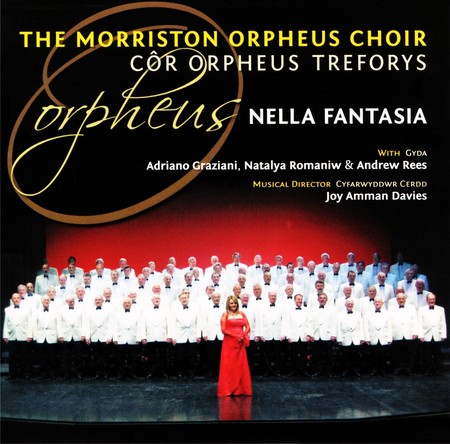 |
|
Nella Fantasia ~ Deus Salutis (Llef) ~ Deep River ~ Let all men sing ~ GwÅ·r Harlech ~ The rose ~ Y delyn aur ~ I’ll walk with God (with Andrew Rees) ~ The prayer ~ Nidaros ~ Cabaret ~ One day I’ll fly away ~ Comrades in arms (Les enfants de Paris) ~ Lisa Lân ~ Abide with me ~ Time to say goodbye (Con te partiro) (with Adriano Graziano and Natalya Romaniw) Joy Amman Davies ~ Musical Director; Jo Scullin ~ accompanist; Michael Williams ~ accompanist; Leslie Ryan ~ organist; Adriano Granziani ~ tenor; Natalya Romaniw ~ soprano; Andrew Rees ~ tenor, with Peter Williams ~ keyboard, synths and sequencers; Wyn Pearson ~ guitar |
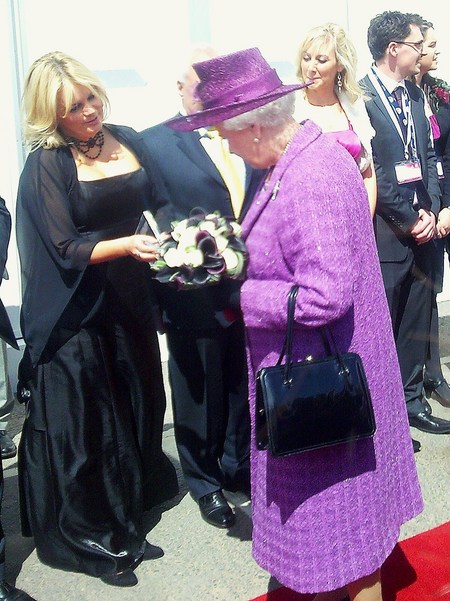 |
| Joy presents H M The Queen with a copy of Nella Fantasia |
During the 75 years of the Choir’s existence, not only has its members and musical staff changed but also the town of Morriston and its environs. The heavy industries so important at the time of the Choir’s birth have long gone, being replaced with more modern manufacturing and service industries. Felindre steelworks has been replaced by the DVLA and the Enterprise Park, leisure facilities are far more numerous and available, the Welsh language and chapel attendances have declined and musical tastes have changed. These changes have been mirrored with the Orpheus. Its membership is now largely English-speaking living in an area ranging from Haverfordwest in Pembrokeshire to Bridgend and beyond in the East.
The Choir features regularly on TV and its recordings (over 60 and is featured in over 100 compilation CDs and LPs) are in great demand on radio programmes. Here is a brief selection of numbers recorded between 1976 and 2010
- Playlist item
Successful ventures into the "pop" world have included recordings with chart-topping T'Pau and the Welsh group, The Alarm. Most recently it has recorded with eighties "pop icon" Howard Jones and is featured on the CD Ordinary Heroes. Current recordings are available for purchase at concerts and from our secure on-line shop
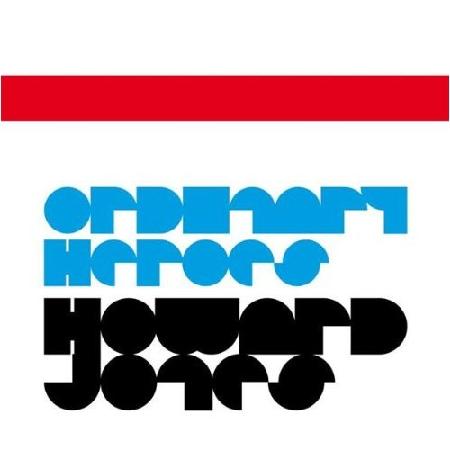 |
Released in 2009, the CD Ordinary Heroes by synth-pop legend Howard Jones who recorded a special track with the Moriston Orpheus Choirr |
| With Synth-Pop icon Howard Jones, in concert at Cardiff's St. David's Hall 2009 | |
Often called the unofficial ambassadors for Wales, the Choir is internationally-acclaimed as a leading exponent of male choral singing. Within the United Kingdom the Choir is in constant demand with around 25 engagements a year, including concerts, TV and after-dinner performances. Although itself a registered charity and financially self-supporting, much of its work is devoted to assisting local and national good causes, at home and overseas, such as Leukaemia Research, Action for Children, RNLI, Air Ambulance Wales, Royal National Eisteddfod, Urdd Gobaith Cymru and Save the Children Fund.
The aims and values of the Choir, however, remain unchanged. During the whole of its existence it has striven to follow the advice, attributed to Sir Walford Davies in a speech in Swansea on that same April week in 1935 when the Choir was formed, to “make music joyously”. Long may it continue to do so.
We are grateful to Alun Howells for compiling this history of the Choir, with additional contributions from Huw Madoc-Jones, Roy Pugh, Dudley Williams, Les Ryan and Alan Lewis.
Here is a ten minute slide show of photos from the 75 years with classic songs / hymns accompanying the photos
Alun Howells was a member of the Choir for over 50 years. We have a Special Feature to mark this.

